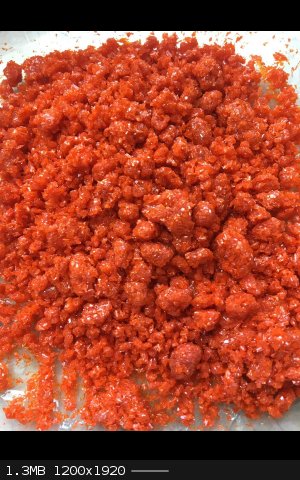
woelen - 10-1-2010 at 06:06
In this webpage I describe the synthesis of an interesting reagent, potassium chlorochromate(VI). This is a strong oxidizer, which is soluble in many
organic solvents. In acetone its solubility is very good.
The webpage describes the synthesis and the trade-off between purity and yield. The procedure given here gives a yield of 43% while having good
purity.
http://woelen.homescience.net/science/chem/exps/KCrO3Cl/inde...
ScienceSquirrel - 10-1-2010 at 06:45
The equally interesting pyridinium chlorochromate was prepared and used by Corey and Suggs in organic synthesis.
Eclectic - 10-1-2010 at 13:31
if you have CrO3, could this be made using KCl?
woelen - 11-1-2010 at 01:29
I do not believe that simply mixing KCl and CrO3 will do the job. If you heat such a mix, then the CrO3 will decompose.
What will work though is dissolving CrO3 in conc. HCl and adding KCl to such a solution, such that there remains just a slight excess of CrO3. You
will need heating the solution in order to get the KCl dissolved. It might even be a good idea to first add the KCl to 25% HCl and when all of it has
dissolved and the liquid is still warm then you add the CrO3. The latter will dissolve very well.
Again, yield will not be spectacular, with CrO3 I also expect a yield of not better than 50% due to limited solubility of KCl in 25% HCl at moderate
temperatures. Increasing temperature improves solubility, but then the addition of CrO3 also will lead to the redox reaction in which chlorine is
formed and trivalent chromium.
Formatik - 11-1-2010 at 15:29
CrO2Cl2 also reacts with paper tissue fairly quickly turning it green as it is reduced to Cr2O3.
vano - 2-1-2021 at 08:37
Very nice compound. This is my chlorochromate.

Bedlasky - 2-1-2021 at 09:49
Nice! I also plan make this compound (and also chromate and trichromate), but I am not in mood right now.
vano - 3-1-2021 at 02:27
Thank you! I want to try fluorochromate and other halochromated. I wonder how many different colors they will have.
Bedlasky - 3-1-2021 at 03:43
I don't think that you can make other halochromates than fluoro and chlorochromates. Iodide is readily oxidized by dichromate to iodine and CrO2Br2 is
stable only at low temperatures in halogenated solvents.
vano - 3-1-2021 at 03:47
I meant bromine. I have quite a lot of hydrobromic acid and I will do it. I also think iodine will not work.
Bedlasky - 3-1-2021 at 04:28
CrO2Br2 is quite unstable, it can be prepared only at very low temperatures (-60-(-80)°C). At room temperature is unstable and decomposes. I assume
that the same is true for KCrO3Br. You cannot prepare it at normal conditions. When you mix K2Cr2O7 with HBr, you get Br2 and CrBr3. Look at this:
https://chemistry.stackexchange.com/questions/95286/why-do-c...
I will make my personal list of experiments which requires dry ice and when I will have everything ready, I will order some dry ice and do these
experiments. CrO2Br2 preparation is one of them.
vano - 3-1-2021 at 04:36
Is it clear. If it is unstable I will no longer waste hydrobromic acid.
vano - 3-1-2021 at 04:36
Is it clear. If it is unstable I will no longer waste hydrobromic acid.
